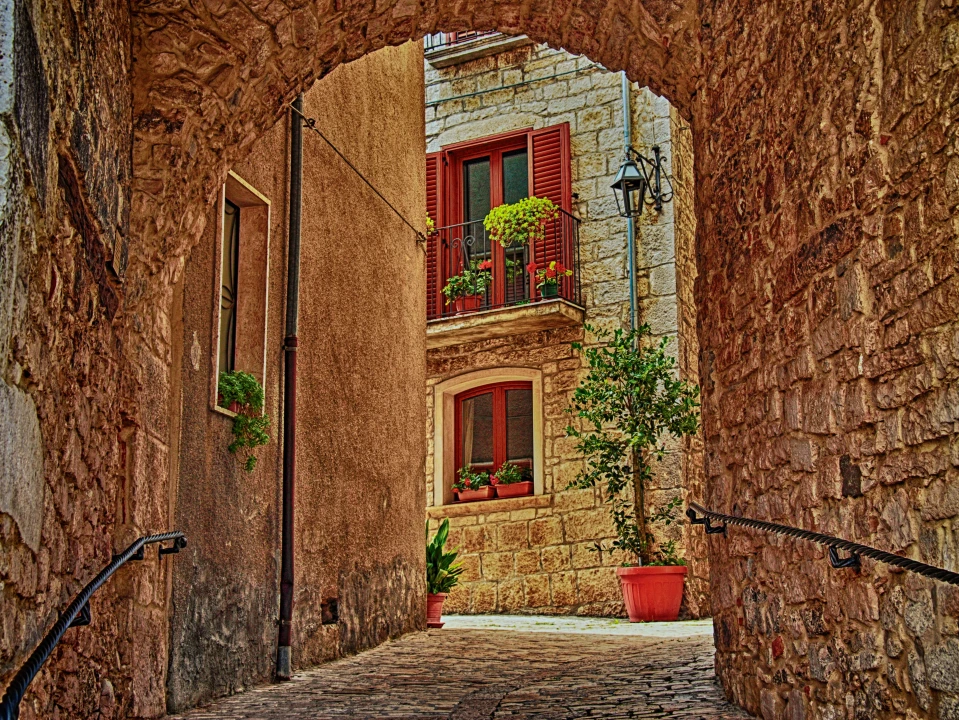The talented local craftsmen of Oratino could express their art mainly thanks to the patronage of the Dukes Giordano (VI-VII century). Portals, balconies, balustrades of the aristocratic houses, as well as the interior of the churches represent the noble work by blacksmiths, stonemasons, gilders, glaziers and painters. A historian described Oratino as "a place where many arts in perfect taste are cultivated" (1781).
In fact, there are no other towns in Molise that can boast such a concentration of artists and artisans. Many of them trained in Neapolitan school and left traces of their work until the areas of Capitanata, Sannio Beneventano and Abruzzo.
The tour begins from the Church of Santa Maria Assunta, in the old town. The building was already reported in a document dating back to 1251. The church was renovated several times, especially after the earthquake of 1456; the vault of the nave preserves a fresco representing an “Assunzione della Vergine” by Ciriaco Brunetti completed in 1791. The rocaille style (an artistic style preceding the rococo) used by this artist from Oratino emerges particularly in the preparatory studies for the decorations of vaults, ceilings and trompe-l´oeil.
Santa Maria Assunta also houses a silver monstrance by the goldsmith Isaiah Salati, a Ciriaco Brunetti’s grandson (1838).
Out of the village is the Church of Santa Maria di Loreto, where you can admire the applied art of carving. Here are two interesting statues representing a Madonna del Rosario (XVII century) by the sculptor Carmine Latessa, and a Sant’Antonio Abate by Nicola Giovannitti (1727). This is a typical country church, expanded in length throughout the present rectory during the first half of the nineteenth century, while the façade dates back to the 1718. The vault of the nave and the two side aisles were painted by Ciriaco and Stanislao Brunetti.
Coming back to the village you get to the Ducal Palace; designed as a fortified castle in the fourteenth century, it became an aristocratic mansion (XVIII century) and today, unfortunately, is privately owned.
Magnificent stone portals, such as the Doge´s Palace and Casa Giuliani, lead us to remember other fine artists from Oratino: the stonemason Domenico Grandilla, the sculptor Silverio Giovannitti, the gilders Giuseppe Petti, Agostino Brunetti and Modesto Pallante, as well as the painters Franco Brunetti, expression of the late Mannerist culture, and Niccolò Falocco, with his sanguine paintings full of chiaroscuro effects, who is indicated as a pupil of Solimena that is the greatest exponent of early eighteenth-century Neapolitan painting.
Going on via Piedicastello, or walking along Piazza Giordano on a summer night, or even looking out to the viewpoint to admire the Biferno valley (Oratino is a two-faced village), you can catch something mysterious about this place. As if the excellent local worked stone, engraved and lost in the vicissitudes of the centuries, such as the medieval tower that stands alone and broken on a precipice, represented the eternal repetition of transhumance.
The high rock defended by Samnite walls still oversees the ancient paths of flocks, the ways of grass that go down following the natural conformation of these places.
Sheep tracks disappeared as well as the system of social relationships that the slow gait of herds allowed.
Today, just the flavours of bread, oil, cheese and the last fires of civilization and pastoral farming remain; especially on the Christmas night when the day is shorter but hope grows.
The name
The village first was called Loretinum (XII century); the name changed in Ratino (XV century), then it became Loratino and finally Oratino. The origins of this word are still unknown. According to the parish priest of the early twentieth century the place name has the Greek root or- from which the Latin word Oratenus, meaning first "visible from everywhere" and then "panoramic point”, derived.
The product
Legumes. Chickpeas and chickling vetches are the main ingredients with the wheat of the “Lessate”, the recipe that is cooked on the churchyard on January 17, while bonfire burns in honour of Sant’Antonio Abate.




